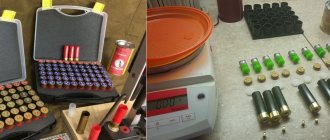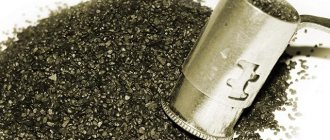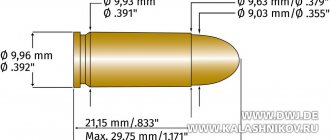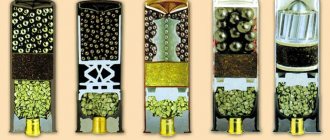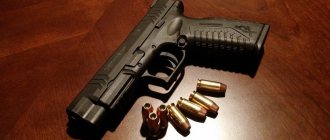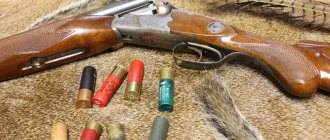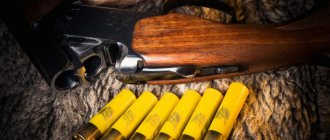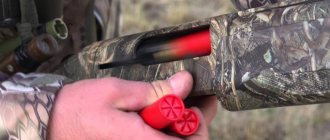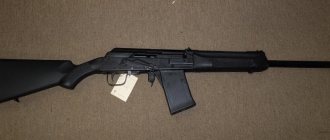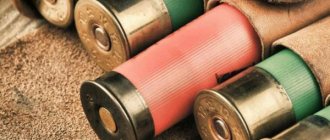Why load your own ammunition?
There are several undeniable arguments, and hunters who repeatedly ask how to load 16-gauge cartridges are advised to get acquainted with them.
The first factor is economic
Early on, it was noted that low cost made 16-gauge ammunition affordable to most hunters. Self-preparation helps lower this threshold, providing tangible savings.
The average cost of a 16-gauge cartridge in specialized hunting stores is 25 rubles. Even purchasing a large batch of ammunition while hunting will not lead to large financial costs. However, in this case, the low cost of cartridges is due to the corresponding quality.
The second factor is quality.
Professional shooters using ammunition in this price segment noted the following problems:
- Cheap gunpowder, which did not impart the necessary power to the shot, often became damp under the unfavorable conditions of the Russian climate. High humidity and rainy weather are literally a death sentence for such ammunition, so you can’t count on a high-quality shot.
- Harmful lead. At first glance, it may seem that this factor is not decisive, since the shooter does not load the cartridges himself and does not come into direct contact with it. But the catch is that toxic substances are released at the moment of firing under the influence of high temperature. Frequent use of such ammunition over a long period of time can lead to health problems.
- Sleeves made of second-class plastic. It's not that they're flimsy or flimsy. Such cartridges often burn out when the gunpowder ignites, rendering the shot ineffective.
- Frequent misfires. This is where the problem with the capsules comes into play. Keep in mind that reusing a cartridge that did not work the first time is life-threatening.
All of these problems can be avoided if:
- purchase high-quality domestic cartridges;
- equip a hunting rifle with foreign-made ammunition.
But here the first factor comes into force - the question of price. The cost of similar 16 gauge cartridges is 2-4 times higher! Branded manufacturers often set a price tag of 100 rubles per cartridge. This price is fair, since the manufacturer guarantees the quality of the cartridge and the safety of its use.
The high cost of first-class ammunition forces hunters to look for an alternative solution - affordable, high-quality, expedient. They become their own equipment.
Preparing 16-gauge cartridges does not pose any great difficulties, provided that the level of the shooter himself gives him the right to engage in such a procedure. Of course, there are many nuances here that should not be overlooked:
- amount of gunpowder;
- correct processing of the sleeve;
- loading order;
- fraction selection;
- use of suitable consumables.
Experienced shooters even take into account the type of bird or game they are going to shoot. This helps to achieve ideal shooting performance from a 16-gauge smoothbore shotgun. Next, we will try to cover as much as possible the process of independently loading ammunition with shot, but for now we will devote a few words to other advantages of such cartridges.
Advantages of rolling papers
The most important advantage is the ability to choose. If manufacturers usually limit hunters to a narrow range of ammunition, then self-equipment helps to select cartridges taking into account the level of the shooter, external conditions and characteristics of the rifle.
By preparing the cartridges on your own, you can be completely confident in their quality. By following safety precautions and the correct manufacturing procedure, you can reduce the likelihood of a misfire to zero, while achieving:
- high initial speed;
- shot whiplash;
- required power.
It is the quality of rolled cigarettes that is the decisive factor for many 16-gauge lovers. The hunter receives ammunition, the market price of which is equal to 50-100 rubles, but the cost of each cartridge is even less than 25 rubles.
Adjusting the powder weight is an important indicator. This helps to take into account the features of a smoothbore gun and minimize barrel wear with each shot. Using high-quality dry powder, the shooter can be confident in protecting the receiver elements from corrosion. This is due to the low content of chemically caustic substances present in cheap, low-grade ammunition.
This factor is also important because it helps extend the service life of a hunting rifle. You won't need an arrow:
- spend a lot of time/effort on cleaning and maintaining the gun;
- spend money on repairing smooth-bore weapons;
- look for spare parts for a rifle of a certain model.
Selecting the right size shot is another undeniable advantage. So, when hunting a bird, you don’t have to worry that it will be riddled with small pellets, the extraction of which is a real test for the fisherman.
It is worth taking into account the material used to make the shot itself. Low-quality lead is dangerous not only for the shooter, it also causes a lot of harm to game, making the meat unsuitable for consumption. Good, strong steel deforms much less when it hits a target and damages the skin less when it comes out. In general, this has a positive effect on hunting.
Possible disadvantages
There are also disadvantages, and you need to remember them when deciding on your own equipment. The main disadvantage is the lack of special equipment.
Remember: loading cartridges “on the knee” is not an option! This will not lead to the desired result. Homemade ammunition is dangerous to health and life, so it is better to abandon such an idea immediately.
Self-production of 16-gauge cartridges is suitable only for commercial hunters who regularly go outdoors, have the necessary license to shoot game and need high-quality ammunition. Yes, self-made cartridges are cheaper, but considerable costs will be required at the stage of preparing the necessary equipment for their production.
In order to save money, it is possible to purchase used equipment, but here it is recommended to enlist the opinion of an expert who has dealt with a rolling machine and can easily note even the slightest deviations from the norm.
Time is another resource that needs to be managed. Correct selection of proportions, accurate weighing of gunpowder/shot, proper preparation of cartridges and the rolling process itself - all this requires maximum attention and accuracy, as well as a lot of time. Don't make cartridges hastily.
Loading 16-gauge ammo will be particularly time-consuming initially, so be prepared for this. But the resources spent, including financial ones, can quickly pay off and bear fruit. Many hunters buy hand-rolled cigarettes through acquaintances, trusting the quality. If you can get the hang of making truly top-notch 16 gauge ammo, that will be a nice bonus.
Information for loading cartridges
CASES FOR HUNTING SHOTGUNA necessary accessory for every breech-loading shotgun is cartridge cases.
The size and quality of the capsule, the care taken in making the socket into which the capsule is inserted, the strength and tightness of the walls of the cartridge case, the overall dimensions of the cartridge case and the correctness of their calibration - all this affects the quality of the shot, as well as the service life of the gun.
Currently, our factories produce the following cartridges for shotguns:
- hunting metal cartridges of 12, 16, 20, 24, 28 and 32 calibers, 70 and 65 mm long;
- hunting paper (folder) cartridges of 12, 16 and 20 calibers, 70 and 65 mm long.
Paper cartridges are made for a closed capsule and for an ordinary open hunting capsule “Tsentroboy”.
Sleeves serve to combine and protect from atmospheric influences all elements of a loaded hunting cartridge.
A metal hunting cartridge case (Fig. 209) is a seamless tube, the bottom of which has a flange (or side) and a socket (for inserting an open capsule) with a stamped anvil and three ignition (or seed) holes.
A paper hunting cartridge case (Fig. 211) is a paper tube rolled up in several layers, one end of which is open, and a metal head is firmly attached to the other, which has a socket for the capsule and anvil in the center.
The metal head with the paper tube is press-fitted using a paper wad, which is called the case base wad.
As can be seen in Fig.
211, a paper sleeve for an ordinary “Tsentroboy” capsule also has an anvil, which is a metal comb with a shank, with which it is inserted into the hole of the capsule socket. Rice. 209. Metal seamless sleeve for shotguns: 1 - wall; 2 - bottom or cap; 3 - dulce; 4 - capsule socket; 5 - anvil; 6 - seed or ignition holes; 7 - edge or side
Rice. 210. Paper sleeve for shotguns under the “Zhevelo” primer: 1 — paper tube; 2 - metal head; 3 - bottom; 4 - dulce; 5 - capsule socket; 6 - edge or side; 7 - paper wad of the base of the sleeve Fig.
211. Paper sleeve for shotguns with an anvil for an open primer of the central fire: 1 - paper tube (case wall); 2 - metal head; 3 - bottom; 4 - dulce; 5 - capsule socket; 6 - anvil; 7 - edge or side; 8 - paper wad of the case base. In each box with cartridges under the open primer of the central fire, at least 140 anvils (for 100 pieces of cartridges) are placed in a separate bag.
Metal and paper casings for an open, ordinary “Central Shot” primer are intended for firing shot and bullet from hunting smoothbore rifles using black powder; paper cartridges with a capsule socket for a closed Zhevelo capsule, which has an anvil embedded inside, for firing smokeless powder (Fig. 210).
Both paper and metal sleeves have positive and negative properties.
Metal (brass) shells for shotguns have two positive qualities compared to paper ones: firstly, efficiency (a metal shell can be loaded several tens or even hundreds of times), and secondly, strength (they are moisture resistant, their dimensions change little under exposure to dampness, and these sleeves are not permeable to gases).
Negative properties of metal sleeves:
- they are heavy;
- it is impossible to hold shot in them with a light shot wad, which is most suitable for achieving a better fight;
- It is not recommended to fire smokeless powder from them;
- they do not fit so tightly to the walls of the chamber during a shot at relatively low pressures of powder gases (300-400 atm).
In turn, paper cartridges quickly become wet, swell and do not fit into the chamber of the gun. As a rule, they can withstand no more than two shots.
But paper cartridges are good because they make it possible to use smokeless powder and a light shot wad. And this ensures high shot flight speeds and increases other ballistic indicators.
Every shotgun shooter needs to learn the following.
- The main principle of shotgun ballistics is that the more accurately the channels of the cartridge case and the barrel coincide at the moment of the shot, the better the quality of the shot will be. On the contrary, the smaller this coincidence, the greater fluctuations in the firing of the gun should be expected from shot to shot in the number of pellets hitting the target, as well as in the uniformity of their distribution on the target.
In addition, a case bore that is too wide leads to an increase in gas pressure, which is not always safe for the gun, especially with fast-burning (sharp) varieties of smokeless powder.
- The diameter of the cartridge case must correspond to the chamber of the gun. A case that is too loose allows gases to escape through the chamber, reduces ballistic performance (velocity, accuracy, etc.) and covers the block and mechanism of the gun with soot.
- The primer must fit tightly into the sleeve socket. If the primer is poorly fitted, gases break through the primer socket, contaminate the firing pins and that part of the block into which the bottom of the cartridge case rests, and in hammerless guns they even get into the striking mechanism.
- The cartridge case must fit freely into the chamber. All tight-fitting cartridges loosen the bolt and damage the extractor. They especially quickly wear out the ejector of the gun and even lead to breakdown of the ejector mechanism. In addition, such cartridges slow down the rate of fire and cause delays when firing.
- The diameter of the rim (side) of the cartridge case must fit freely into the rim (recess under the case head) of the chamber. A case bottom that is too thick does not allow the bolt to accurately place the barrels in place, and rims that are too thin (small in diameter) lead to cartridges sinking, prolonged shots and even misfires, especially in guns with a short firing pin stroke.
ABOUT THE CORRESPONDENCE OF THE LENGTH OF THE CASE TO THE LENGTH OF THE CHAMBER
For shooting to be successful, the cartridge case - metal or paper - must be slightly shorter than the chamber. Otherwise, the gun will give a strong push to the shoulder, and the shot will be defective.
Many hunters, wanting to measure the length of the chamber in their gun, usually make mistakes:
- or they measure it using a metal sleeve, while forgetting about the gentle transition from the chamber to the bore;
- or they measure it with a cartridge loaded into a folder sleeve, losing sight of the fact that a 70 mm cartridge after twisting the free edge of the sleeve has a length of only 64-65 mm.
In order to accurately measure the length of the chamber, you need to make a cast from cutting sulfur, wax or paraffin. It should be borne in mind that wax and paraffin wrinkle easily when they are pushed out of the chamber, as well as during the measurement process.
The cast is made like this: a thin layer of gun oil is applied to the chamber and the beginning of the barrel behind the chamber by about 30-50 mm. Then, from the side of the muzzle to the border of the lubricated area, a felt wad 2 calibers larger than the size of the bore is inserted.
After this, molten sulfur, wax or paraffin is poured into the chamber.
The barrels with the filled mass are cooled for some time in a vertical position. When the cast has hardened, it is pushed out (from the barrel) and measured to the nearest 0.1 mm *.
- * In the absence of an appropriate tool, measurements can be made with a scale or metal ruler with an accuracy of 0.5 mm.
The paper sleeve (not twisted) should be 0.5-1.0 mm shorter than the chamber, since when fired, its tube is somewhat stretched.
An excessively long cartridge case enters the chamber with difficulty, leads to a sharp increase in the pressure of the powder gases, which greatly compress the projectile and the powder wad on the slope from the chamber to the bore, and spoils the battle.
When fired, a long, non-chambered, folder case unfolds a curled edge, lies on the slope from the chamber to the barrel bore and thus compresses, rearranges the shot shell and deforms the powder wad, as a result of which cartridge cases break through between the walls of the barrel bore and the wad, compressed by the barrel powder gases.
As a result, the flight speed of the shot decreases and the pellet of the shot shell deteriorates. Sometimes the shot sticks together into a lump. This happens especially often with soft, unheated shot with a specific gravity of 11.25-11.30.
If the powder wad and projectile are excessively compressed, as shown in Fig. 212, the pressure of powder gases in the 12th caliber increases as follows: with black powder - by 40-50 atm, with smokeless powder - by 70-100 atm. In 16- and 20-gauge guns, this difference (with smokeless powder) reaches 150 atm or even more.
Rice.
212. A - a sleeve of normal length along the chamber of a gun (a sleeve 65 mm long, a chamber 65 mm long): I - before the shot; II - at the beginning of the shot; B - the sleeve is too long, not in the chamber (the chamber is 65 mm long, the sleeve is 70 mm); III - before firing - the length of the twisted cartridge is 65 mm, it fits freely into the chamber; IV - at the beginning of the shot, the muzzle of the cartridge case, compressed by the slope, compresses the wads and rearranges the shot: in this case, the pressure of the powder gases sharply increases and the pellet of the shot shell worsens as a result of the breakthrough of powder gases into the projectile. In the event that the cartridge case is shorter than the chamber by more than the thickness of the gases compressed at shot of a powder wad, then the battle also worsens, as gases break into the shot shell (Fig. 213).
True, in this case, the deterioration of the ballistic parameters of the shot does not pose a threat to the strength of the gun, but it sharply reduces the consistency and sharpness of the battle. Rice. 213. An excessively short cartridge case, not in the chamber, causes a breakthrough of powder gases into the shot shell at the beginning of the shot, which leads to a deterioration in the engagement - it reduces the accuracy, sharpness and consistency of the engagement from shot to shot, but the pressure in the chamber does not increase CASE DIMENSIONS At the bottom of the cartridge case stamps are applied - numbers or letters - which indicate the caliber, year of manufacture and brand or name of the plant (Fig. 214, a and b).
Rice.
214. a - dimensions of metal cartridges for shotguns according to OST 40168; b - stamps on the bottom of metal cartridges: 12 - gauge; 45 and 46 - year of manufacture The best material for sleeves is brass. Brass cartridges can withstand more than 50 (up to 100) shots if handled carefully during reloading.
Iron cartridges suffer from significant disadvantages. Due to less elasticity, the fit of the walls of the iron case to the walls of the chamber is less dense at the moment of firing, which is why a more significant breakthrough of gases back occurs. Iron cartridges, as a rule, after four to five shots develop longitudinal cracks in the tube and become unusable. Iron cartridges are more susceptible to oxidation under the influence of moisture and explosive decomposition products of gunpowder and primer.
When fired repeatedly, brass cartridges, especially in the front, swell noticeably.
Therefore, before equipping, the sleeves must be calibrated by passing them through the calibration ring (Fig. 215). The same must be done if they use cartridges that were fired from another gun, especially one with wider chambers. Rice. 215. Calibration ring for metal sleeves (to table 25) TABLE 25. SIZES AND CALIBERS OF RINGS (to fig. 215)
| Caliber | Dimensions in mm | |
| B | C | |
| 12 | 20,50 | 20,15 |
| 16 | 19,00 | 18,80 |
| 20 | 17,60 | 17,30 |
| 24 | 16,65 | 16,40 |
| 28 | 15,75 | 15,50 |
| 32c | 13,45 | 13,25 |
Cleaned cartridges, lightly lubricated with machine or gun oil, are driven through the ring with light blows of a wooden hammer and pushed out of the ring by blows of the hammer on a wooden stick or metal rod.
Brass oxidized cartridges (covered with green spots) are cleaned of carbon deposits in leaven grounds, washed with warm water, and then wiped dry and stored in a dry place.
Rice. 216. Dimensions of paper cartridges for shotguns according to OST 40169: a - paper sleeve for the Zhevelo primer; b - paper sleeve for the open primer of the central fire; c — anvil to the paper sleeve under the open primer of the central fire; g - stamps on the bottom of paper sleeves: 12 - caliber, 50 - year of manufacture
| TABLE 26a. DIMENSIONS OF METAL CELLS ACCORDING TO OST 40168 (to Fig. 214) | ||||||
| Caliber | Dimensions in mm | |||||
| A | B | C | h | Sleeve length L | ||
| normal | elongated | |||||
| 12 | 22,45 | 20,60 | 20,20 | 1,80 | 65 | 70 |
| 16 | 20,65 | 18,85 | 18,55 | 1,55 | 65 | 70 |
| 20 | 19,40 | 17,70 | 17,25 | 1,50 | 65 | 70 |
| 24 | 18,35 | 16,75 | 16,45 | 1,50 | 65 | 70 |
| 28 | 17,40 | 15,85 | 15,55 | 1,50 | 65 | 70 |
| 32c | 15,75 | 13,55 | 13,30 | 1,50 | 65 | 70 |
| TABLE 26b. DIMENSIONS OF PAPER CASES ACCORDING TO OST 40169 (to Fig. 216) | ||||||||
| Caliber | Dimensions in mm | |||||||
| A | B | C | F | D | h | Sleeve length L | ||
| normal | elongated | |||||||
| 12 | 22,45 | 20,60 | 20,35 | 18,65 | 20,25 | 1,80 | 65 | 70 |
| 16 | 20,65 | 18,85 | 18,70 | 17,00 | 18,60 | 1,55 | 65 | 70 |
| 20 | 19,40 | 17,70 | 17,50 | 15,80 | 17,40 | 1,50 | 65 | 70 |
| 24 | 18,35 | 16,75 | 16,60 | 14,90 | 16,50 | 1,50 | 65 | 70 |
Original: https://www.sportguns.ru/
Necessary tool
This aspect scares off many novice hunters. Indeed, the selection of equipment and necessary tools makes the process of loading cartridges labor-intensive and confusing.
If you approach this issue wisely, you need to start by preparing the room. A garage, shed, or workshop are quite suitable for this. The main thing is to comply with a number of fundamental requirements:
- access to the premises should be limited as much as possible (entry by unauthorized persons and children is not allowed);
- the air must be dry so that the gunpowder does not become damp;
- the work area must be equipped with a workbench with drawers that can be locked with a key.
The main device at the disposal of a commercial hunter is a machine.
Rolling machine
The advantage of this simple device, reminiscent of an ordinary vice, is the fast, high-quality, convenient preparation of cartridges. Thanks to special clamps, it can be easily installed on a workbench or any flat surface. The bottom flat screw needs to be screwed all the way in and tightened as tight as possible (just be careful not to overdo it to avoid stripping the threads).
The main tasks of this machine include:
- rolling of cartridges (can be round or in the form of an asterisk);
- pressing of shot/powder.
When choosing a machine, take into account individual preferences: someone, for example, likes the “star” better. Make sure that all machine components are made of strong, wear-resistant steel, are as smooth as possible and move easily in the plane.
At first, it is not advisable to purchase an expensive machine that has many auxiliary functions. For normal loading of 16-gauge cartridges, a standard machine from the Soviet period is suitable. The main thing is that all its parts are intact.
If you purchased a used machine, but of good quality, clean it of debris/carbon deposits/dust, and then renew the lubricant. Both regular machine oil and fuel oil will do.
Choosing scales
The best choice would be electronic pharmacy scales. Praise be to technological progress! Modern commercial hunters can forget about the times when it was necessary to measure the mass of gunpowder/shot on ordinary scales.
Make sure the device gives accurate readings (this is important). Standard steel weights weighing a few grams are suitable for testing (the range can be quite wide) . The main thing is that the scales must accurately measure the mass in milligrams.
Under no circumstances should you use a device that produces an error. Remember that even 1 extra gram of gunpowder can lead to very serious consequences for both the shooter and those around him.
It is recommended to pour gunpowder and shot into metal containers. Buy a bowl made of steel that will not interact with chemicals. Install it on an electronic scale, reset the readings to zero and you can start weighing the components.
Capsule extractor
It greatly simplifies the process of removing primers from cases, and also helps avoid damaging them in the process. When purchasing this device, make sure it is easy to use. You can check this directly in the store, and if you have any difficulties, ask the seller for advice.
2.3.2.6. Inserting felt powder wads into the cartridge case
2.3.2.6. Inserting felt powder wads into the cartridge case
Inserting felt powder wads into the case and adding a cardboard spacer under the projectile to them is carried out similarly to inserting a cardboard powder wad into the case using the same instruments, fixtures and techniques.
The thickness of the main (lower) wad should be no more than half the caliber of the gun in millimeters with a deviation of +1 mm and is equal to: for 12 gauge 10 mm; for 16th - 9 mm; for the 20th - 8 mm, etc. It would seem that a higher wad would provide better obturation, but due to its significant weight, at the moment of departure from the barrel, it can wedge a shot shell, which will significantly worsen the combat of the gun. There can be one such wad in the case, or additional wads of similar or less height are placed on top of it, which is associated with the used case, charge, projectile and method of attaching the latter. There can be 1–2 or more additional wads, but each of them should be smaller in height than the main one. It is important that when the cartridge case exits the muzzle, the total height of the powder wads overlaps the transition cone between the chamber and the barrel by 2–5 m, which will prevent the breakthrough of powder gases to the projectile. The total height of the wads is selected in such a way that there is room for rolling or pressing the sleeve.
In paper and plastic cartridges, where the shot wad will be secured by rolling the barrel, 3-4 mm of the free edge of the cartridge is left above the shot wad; when pressing the barrel with an “asterisk”, the height of the free wall above the projectile is 11, 10 or 9 mm, which is associated with the caliber of the sleeve, respectively 12, 16 and 20; the same free edge is left in metal sleeves. The height of the space for the projectile and its fastening in the cartridge case is verified by the second control mark on the rod of the gun.
However, commercially available felt wads vary significantly in height, and it is very difficult to maintain the distance required to seal the case neck. As a result, the projectile in the cartridge is either in a very loose state or very compressed, which negatively affects the stability of the gun. To produce the wads required in height, strictly equal in height and with parallel ends, you should use the recommendations in the section on the manufacture of wads. The easiest way to achieve high quality is not to cut out the wads with a die cutter, but to fix it in a drill chuck and then drill out the wads with it.
In paper and plastic sleeves, caliber wads are used, in metal ones - 2–4 calibers larger, since the internal diameter of the metal sleeve exceeds the diameter of the paper sleeve and the caliber wads fall into the metal sleeve. Therefore, for a 12-gauge brass sleeve, 10-gauge wads are used, for 16-gauge - 14-gauge, and if they are not available, then 12-gauge, etc.
The 10-gauge wads needed to load 12-gauge brass cases are rarely commercially available; There are no die cuts for 10-gauge wads in stores at all, since their production is not provided for by TU 90-583-80. But it’s easy to make a 10-gauge die-cut from a 12-gauge die-cut, increasing the internal diameter of the latter by boring it to 19.9–20.0 mm.
Wood-fiber wads reduce pressure and speed, while plastic wads increase them compared to felt ones. Both wood-fiber and plastic wads do not work reliably enough at sub-zero temperatures, which is why in severe frosts it is better to use paper sleeves with felt wads. The influence of the wad material on the size of the powder charge can be judged from the data in Table. 25
and
26
. Of course, these tables do not give the optimal weights of gunpowder and shot, but only the initial ones, based on which the gun should be sighted.
Table 25
Recommended masses of “Falcon” smokeless powder charges and shot shells depending on the wad material
| Weapon caliber | Gun weight, kg | Wad type | Charged porosity (g) at air temperature, °C | Shot projectile, g | |
| +20 | — 20 | ||||
| 12th | 3,2–3,5 | D | 2,3 | — | 32-35 |
| IN | 2,2 | 2,3 | |||
| PC | 2,0 | — | |||
| 12th | 2,8–3,1 | D | 2,2 | — | 30-32 |
| IN | 2,1 | 2,2 | |||
| PC | 1,9 | — | |||
| 16th | 3,0–3,2 | D | 2,1 | — | 28-32 |
| IN | 2,0 | 2,1 | |||
| PC | 1,8 | — | |||
| 16th | 2,7–2,9 | D | 1,9 | — | 27-29 |
| IN | 1,8 | 1,9 | |||
| PC | 1,6 | — | |||
| 20th | 2,6–3,1 | D | 1,7 | — | 26-31 |
| IN | 1,6 | 1,7 | |||
| PC | 1,4 | — | |||
| 20th | 2,4–2,5 | D | 1,6 | — | 24-26 |
| IN | 1,5 | 1,6 | |||
| PC | 1,3 | — | |||
| 28th | 2,2–3,1 | IN | 1,3 | 1,4 | 19-24 |
| 32nd | 2,2–3,1 | IN | 0,95 | 1,1 | 14-22 |
Note : D - wood-fiber wad, B - salted felt wad, P-K - polyethylene wad with a concentrator
Plastic or brass sleeves
Let's move on to an important aspect - what cartridges should be used if you decide to load 16-gauge cartridges yourself? Here it is worth considering the advantages and disadvantages of both options:
- Plastic. They are more often considered disposable, since often after the first shot the damage to the cartridge case is irreversible, and re-equipping it is not possible (especially when using cheap models). The advantage of such cartridges is their moderate weight, which is important during long journeys with large amounts of ammunition.
- Brass. The main advantage is reuse. This simplifies the loading of cartridges and also provides savings (no need to purchase additional cartridges). For equipment, it is enough to carefully remove the shot capsule and install a new, undamaged one in its place. If there is no mechanical damage/deformation on the sleeve itself, then it can be safely used for reloading.
There is an important point to note. Brass cartridges are difficult to see on the ground. They often blend in color with fallen leaves and can get lost in the grass or water. From this point of view, plastic ones are much more convenient, since their bright colors make them clearly visible on the ground.
The process of loading plastic and brass sleeves is somewhat different from each other. If you decide to prepare 16-caliber ammunition yourself, you should study the features of each type separately.
Instructions for loading plastic cartridges
First, stock up on all the necessary components that you will need during the work, namely:
- fraction;
- wads;
- capsules;
- gaskets;
- powder;
- the plastic sleeves themselves.
To make the process of loading ammunition as simple, accurate and fast as possible, use:
- funnel - it is indispensable when pouring gunpowder and shot;
- cartridge stand - ensures the stability of the cartridge case so that you do not accidentally knock them over;
- as a navoynik - indispensable for delivering wads;
- measuring container - it is useful for accurately determining the mass of gunpowder/shot;
- a set of weights - if you suddenly use ordinary scales;
- Sidorenko's universal device - helps to push the capsules all the way.
Sidorenko universal device
Clean up the work surface, arrange all the listed components so that it is convenient, and proceed to equipment. First, inspect all the cartridges and put aside those whose condition is suspicious (there are nicks, cracks, tears, any damage).
Next, measure out the required amount of gunpowder using an electronic scale. Here it is necessary to take into account the recommendations of the gunpowder manufacturer (instructions and proportions should be indicated on the packaging). When weighing, it is worth considering seasonality (the difference in milligrams affects).
After this you need:
- pour gunpowder inside whole cartridges, press it in;
- install the gasket on top of it (insert until it stops);
- measure out the required amount of shot and pour it inside;
- roll the edges of the sleeves using a machine.
Having completed this procedure, it is recommended to take a marker and write on the cartridge case the number of the shot that was filled in when loading. This will make it easier to navigate when choosing ammunition.
The procedure is not very difficult, but always remember that you are responsible for your life, as well as for the safety of people nearby. Even the slightest miscalculations are unacceptable, since they can lead to dire consequences and cause colossal harm to health (death is not excluded). Be extremely careful, attentive and precise. Don’t be lazy to double-check the mass fraction of gunpowder and shot 2-3 times and make sure that the cartridges are properly rolled.
Equipment brass shells
The procedure for their preparation is practically no different from the diagram given above. But there is an important difference that needs to be noted. Most often, rolling brass cartridges is not required, since this leads to their damage, and if used incorrectly, it can even lead to rupture of the cartridge in the barrel.
The solution is to install quick-burning gaskets. They are installed at the final stage after the shot is poured into the cartridge case. If necessary, several spacers can be installed to ensure they are flush with the edge of the brass sleeve.
Typically, gaskets are made to fit the diameter of a 16-gauge cartridge, so they fit tightly. However, many shooters prefer to tape them over the case. This ensures that the gasket itself does not fall out when carrying ammunition.
To conclude this section, it is worth noting that the gasket installation technique is also applicable in the case of plastic sleeves. This not only simplifies the equipment process, but also helps to increase the accuracy of the battle, which is especially important at long distances.
Cartridge in brass sleeve
photo: Fotolia.com
In addition, I hunted with a “twenty” for 20 years, and it was impossible to find even brass cartridges for it during the day with fire. The accumulated experience gives reason to believe that with a properly equipped cartridge you can count on success up to forty meters. But for critical long-range shots you still need a different cartridge case.
But in 2002, in the magazine “Hunting and Hunting Management,” commercial hunter N. Kirgintsev made a statement about the complete advantage of a brass sleeve over a folder one. In addition, he argued that only in a brass case can magnum charges be used effectively, and only with it can a gun be “killer.” The author did not reveal the secret of his “magnum”, advising only to turn to magazines of the 60s, which allegedly published the dependence of pressure on weights.
I am not going to bring to the “ROG” court the questions that have arisen for the author. But a logical confirmation of his “theoretical” calculations could be data from comparative shootings. The author referred to the fact that the accuracy of the shot from a 16-caliber gun was comparable to Ivashentsov’s gun, and surpassed it in sharpness. And again, no numbers.
Frankly speaking, I somewhat doubt the objectivity of Ivashentsov’s own data, since it was possible to implement his ideas decades later, with the receipt of new elements of equipment. Disagreement prompted me to experiment.
No, I did not intend to create a “magnum”, considering myself a sensible person. But I decided to evaluate the difference in combat objectively, with equivalent elements of equipment, excluding the cartridge case. For the experiment, unfired 16-gauge folder cartridges were found for the “centrifuge” primer. And, accordingly, shot brass.
The method of equipment (excluding securing the spacer to the shot), the weight of gunpowder and shot, the thickness of the felt wads and spacers were one to one. I even put a gasket on the shot in a folder sleeve with a thickness of 1.5 mm. Like the author, he shot from an Izhevsk 16-caliber gun.
The accuracy result in a folder sleeve was 10–12% higher with approximately comparable sharpness. My shooting did not give anything new, but only confirmed what had long been known. And I wouldn’t write about this, but links to that publication appear.
The disadvantages of a brass case usually include reduced accuracy, the unsuitability of the CBO primer for igniting smokeless powder, and the difficulty of attaching the gasket to the shot. Yes, reduced accuracy occurs. But from the right barrel, the accuracy is close to that of a cylinder with pressure, which is what is most often needed.
The capsule is unsuitable. Here I would clarify that this is true in relation to 12 gauge, and then in low temperature conditions. They have been talking about the unsuitability of the CBO for a hundred years, and for the same amount of time deep Russia has been igniting Sokol gunpowder with this primer.
There really is a problem with attaching the gasket, if you take into account the old advice - use wax or paraffin. In the era of high-quality adhesives, this is not a question. Personally, I have been using Moment glue for a long time. A thick gasket of at least 1.5 mm inserted with an interference fit, glued with “Moment”, holds it very reliably for two years. And the glue that has dried on the walls creates additional resistance to the shear of the projectile, positively influencing the combustion process of gunpowder.
Why is this seemingly archaic cartridge case still in use among hunters, not only rural ones? In the foreground are economic considerations, in the second is the simplicity of equipment. Of course, I realize that there is a certain nostalgia for the past in my use of brass-cased cartridges. But it's not only that. In my youth I appreciated this cartridge for its reliability in any weather. With a glued gasket on the shot and a primer sealed with varnish, this problem could be forgotten.
You might pull out a cartridge for your favorite “twenty” that had fallen into the accumulated water from the bottom of the boat and, without thinking about how long it had been lying there, you put it in the barrel. And even earlier... Now you are carrying such a heap of necessary things, cartridges, etc. in your car. And then you go on vacation, take 30-40 cartridges for critical shots, three dozen brass, gunpowder, shot and gaskets. You can buy a pack of plasticine in a village shop, and newspapers at that time were in the most remote areas.
Gasket for gunpowder, a very tight-fitting wad made of newspaper, gasket for shot secured with plasticine. With this cartridge he killed hares, foxes, and all kinds of birds, including goose and wood grouse. I saw a game that had been killed, but not by me, equipped with a cartridge - much more serious. Today my brass cased ammo is a 16 gauge with 6-8 shot. But in the past I have loaded a countless number of different cartridges, both 12 and 20. What is needed for high-quality loading of a cartridge with Sokol gunpowder and a CBO primer?
In 12 gauge it is not a sin to drill at least one additional seed hole. I always practice adding black powder under the primer in 12 gauge; in 16 and 20 I did without it. I do not recommend following the recommendations that sometimes exist to combine two explosive compositions in one capsule. The shot will undoubtedly be of better quality, but the eyes are more expensive.
It is also not worth increasing the powder charge to compensate for the low pressure created by the primer. Gaskets with increased diameter will add pressure in the barrel without this. Perhaps the gasket is the component that determines the success of the equipment.
Gaskets should be cut from thick, preferably not hard, cardboard, at least 1.5 mm thick. The diameter of the gasket should be 17.1 mm for 20 gauge, 16 - 18.1 mm, and 12 - 20.1 mm. This gasket fits into the sleeve with an interference fit, allowing you to use a wide variety of materials as a wad. I myself prefer felt non-greased wads.
Felt is suitable for any density. Initially, a thick gasket, or a set of 2.5–3 mm thick, is placed on the gunpowder. If the felt is dense, for example from felt boots, then it is better if the wad is composed of two or three thin ones. It is best to place a caliber wad-shock absorber made of polyurethane foam, twelve millimeters high, on a felt wad. It’s easy to cut them from any package, using a punch grinder or a sharpened tube from a cartridge case. If the felt is not hard, then a pad with a thickness of at least 2 mm is placed on top of the wad and clamped until it stops.
I will make a reservation that the assembly of the cartridge must be tight, the lining must correspond to the diameter of the cartridge case, and the efforts made must be very solid. Especially when installing the powder gasket and pressing the soft wad. Next is a wad made of the same felt or polyurethane foam. All that remains is to fill in the shot, press the gasket tightly and seal it with Moment glue.
A reliable, sharp cartridge with a guaranteed accuracy of 35–40% in the right barrel is ready. The build quality of the cartridge is characterized by the absence of unburned powder particles.
However, options are possible. During loading, the shot can be separated by a spacer(s). Using this cartridge, I hunted snipe a lot and successfully with the Izhevsk “twenty”. On the contrary, you can slightly increase the accuracy by using a cup made of laminated paper. Using a light wad, you can further increase the accuracy by sprinkling shot larger than “five” with starch. All this has been tested and works flawlessly.
I know people who only use loose wads. I have come across publications by very respectable authors who claim that with this option, accuracy increases by fifteen percent compared to equipping with a felt wad. But I can neither confirm nor deny, I haven’t tried it.
My recommendations are only suitable for Sokol gunpowder. I do not recommend experimenting with fast-burning powders. This is where you can get problems not only with charge ignition, but also with unpredictable pressures. Regarding the brass sleeves for the primer, it’s “chewy”. A shot that is as high-quality as possible can be ensured only by gluing a tray into the cartridge case along the height of the primer. I just ask you to take my word for it, since the scope of a newspaper article does not allow me to substantiate this. So don’t rush to throw away the good old brass cartridges you inherited.
If your income allows you to buy cartridges of your choice, or use all the achievements of modern technology, it would be a sin not to take advantage of it. If not, then you can expand the capabilities of your double-barreled shotgun without much expense or hassle.
For those who have not abandoned the brass sleeve, I hope my advice will be of benefit. But I don’t recommend creating any kind of prototype “magnum” in a metal case if you hunt with a regular gun. You won’t get anything good except a blown cartridge case; if you shoot a lot, you’ll blow out the chamber, and premature loosening of the barrels is guaranteed. To all these troubles will be added broken fingers and a lousy fight. I assure you.
Alexander Yarkova July 14, 2014 at 00:00
Using containers
The use of these wads is justified only if you plan to shoot at medium and long distances - from 50 meters or more. The design of the wad-container is designed in such a way that it helps maintain the initial flight speed of the shot much longer than when using ordinary cartridges (plastic, brass - it doesn’t matter).
Wad-container matching for buckshot
They can be used when equipping a standard set of ammunition. Increased velocity and increased shot power make the 16 gauge suitable for hunting both small and large game, including:
- bears;
- moose;
- boar.
The fisherman should always start from the main goal - the characteristics of the animal he is going to hunt. For duck hunting, for example, cartridge case ammunition is sufficient. With the help of shot, even a novice hunter can shoot down a bird on the fly. The increased spread has an effect.
The ratio of shot and gunpowder
It is strongly recommended to adhere to the indications given by the manufacturer itself. This will be the most accurate, correct measure. In general, for comparison, you can give a table using the well-known brand “Falcon” gunpowder, sold in specialized hunting stores.
For the sake of familiarization, we present the popular fraction number 5. In this case, the relationship looks like this:
- 15.3 - 1.7 g of gunpowder and 26 g of shot;
- 15.0 - 1.8 g and 27 g;
- 15.5 - 1.8 g and 28 g;
- 15.3 - 1.9 g and 29 g;
- 15.8 - 1.9 g and 30 g.
Let us repeat: the given values are valid for “Falcon” gunpowder. Please note that they may differ when using black powder No. 3, for example. Before loading 16-gauge cartridges, you must carefully study the instructions on the powder packaging.
In the case of using round bullets or buckshot, the correspondence of masses will differ significantly from the indicators given above. Only the standard fraction is considered here.
In an effort to increase accuracy and increase the initial speed of a projectile, fishermen often increase the mass of gunpowder by 10% . This is done in cases where it is planned to fire at a long distance. However, in this case it is necessary to maintain optimal proportions.
And again about the brass sleeve
It would seem that this question has long been irrelevant, because many have long believed that a person in his right mind would not use this cartridge case. There are others who, agreeing that the CB capsule is weaker than the HF, are most concerned that no one reveals this terrible secret to the hares. And they beat those same hares in vain.
The relevance of brass cartridges is growing with rising prices for cartridges and, perhaps, for many years, brass will be a faithful assistant. Not long ago, V.F. Gurov spoke in ROG in the article “Business Patron” with sympathy for the poor. So, in many cases, a cartridge in a brass sleeve is the very business cartridge.
The fact that many people are showing interest in the brass cartridge case is indirectly indicated by the appearance of plastic caps for shot (Sheinin wads) on wide sale, i.e. the market responded to demand. True, our Kulibins predetermined multi-purpose use for that plug, but such is our mentality.
I myself, being, apparently, not a completely normal person, hunt a lot with a cartridge in a brass casing, which is why I am writing for the same people, in order to be useful. For those who are not interested, I urge you to simply put the article aside and be lenient with other people’s opinions.
Discussion of brass sleeves and everything connected with them also takes place on the Internet. I even found statements that the author’s results with brass shots are superior to those with plastic.
Any cartridge can be of poor quality, but you can believe that it is quite possible to get closer to the result with a brass sleeve versus a plastic one.
And let's start with the first drawback of the brass sleeve - with the discrepancy between the internal diameter and the bore. The statement is true, but outdated. In some plastic sleeves, the difference in wall thickness compared to “brass” is now only 0.05 mm and cannot significantly affect anything.
The following are generally recognized disadvantages. This is a weak primer and difficulties in sealing the barrel, which, according to many, predetermines poor-quality, prolonged burning of gunpowder and, as a result, high muzzle pressure, low shot speed, incomplete combustion of gunpowder, and prolonged shots. But it seems to me that these opinions are based on publications from the 60s, thoughtlessly replicated.
The recommendations of those years on equipping cartridges today evoke nothing but a smile. I just opened the passports of my guns. In a 12-gauge metal case, a cardboard spacer from a folder case with a diameter of 18.8 mm, a thickness of 1.5 plus or minus 0.25 mm was recommended for gunpowder, i.e. with an allowable 1.25 mm, and for shot 1 plus or minus 0, 25 mm, i.e. 0.75 mm was allowed, followed by filling with paraffin so as not to lose the shot. The black powder was supposed to be compressed with the force of the hand, and the wad was to be sent to the smokeless powder without squeezing. It was according to those recommendations that the shot took place with all the above-mentioned shortcomings. “Zhevelo” somehow managed to cope due to the pressure it developed, but the Central Bank did not. I got through it. And my “Falcon” hissed and spat shot until, at the age of 14, I don’t remember for what reason, I marked the outline on the cover of a book with the muzzle of a cartridge case and cut it off with scissors. I selected a pin from a combine harvester according to the inner diameter of the cartridge case, pressed the gasket in, hit a newspaper wad through the pin with a hammer, and never since then have I seen unburned gunpowder in the barrel. Sokol gunpowder has since changed only in the GOST number, and practitioners have developed their own recommendations for equipment. Few people today would think of adding a thin gasket of a smaller size compared to the diameter of the cartridge case to the gunpowder, in any cartridge case.
I will try, to the best of my understanding of the process, to tell you what you need to know so that, with an imperfect cartridge case and primer, the gunpowder still burns in the first third of the barrel. The widely tested Sokol is quite suitable for this; they say that Kruk gunpowder is even more suitable for this, but I have never seen it.
Let's start with igniting the primer.
The more intense the impact on the capsule, the more fully its energy is used. And this is especially important with a low-power capsule, which is what the Central Bank is. It’s easy to draw conclusions for yourself based on the condition of your gun.
Charge compression ratio.
It is fundamentally important that the powder plates are tightly compressed together. Then they, being ignited by the primer, are ignited from one another. Another important point is the volume in which the charge ignites. In a smaller volume, the pressure developed by the capsule will be slightly higher, which in our case is very important. So feel free to squeeze. Recommendations on this matter vary. A compression force of 5-8 kgf on a can of gunpowder up to 10 kgf is recommended. Some authors believe that hand force is sufficient. This is certainly complete nonsense, given the different physical capabilities. And the first ones are not very literate, because the degree of compression in different calibers will also be different. Based on the fact that quantitative force is the degree of influence of bodies, imagine that you need to put a bucket of water on the warrior. It is perfectly acceptable to press with both hands while standing. There is no need to fear that, as some authors warn, the plates will be destroyed and the combustion area will increase. With the Sokol, and even through the gasket, this will never happen. One example from personal observations. My brother, who works as a huntsman, started hitting iron guards with a hammer at the age of ten, and hasn’t grown wiser since then, continues to do this even at 60 - thank God he’s alive.
The influence of wads and spacers on boost pressure.
It seems to me that this process is presented by the authors somewhat simplified. Actually, this process occurs in two interconnected phases. The first phase is characterized by ignition pressure. This is the so-called pyrostatic period. The pressure begins to rise - there is no movement. This pressure determines the volume of the combustion chamber and the degree of resistance to its expansion by the resistance and weight of the projectile. These are wads, gaskets, the projectile itself, plus the seal of the barrel. The more difficult it is for the initially generated pressure to move the wads and spacers, the higher the ignition pressure. That’s why the tension with which wads and gaskets are sent to the powder is important.
Both the thickness of the gasket and the frictional properties of the wad are important. This justifies the use of a felt, non-greased wad, especially in a brass sleeve. Next, the forcing process begins. It is very short and begins from the moment the projectile moves and ends when the latter enters the barrel. And the higher the boost pressure, the better (faster) the charge burns and the more fully its energy is used.
The moment of opening of the cartridge case is very important. Let's simulate the following. The tension of the wads and gaskets is small; the growing pressure after ignition instantly moved the wads, the projectile and the barrel opened. The volume of the gunpowder combustion chamber instantly increased, the pressure dropped, the burning rate dropped, and the gunpowder burned, figuratively speaking, at the end of the barrel. Those. It is preferable that, under all other conditions necessary for boost pressure, the neck should open as late as possible, because a slight delay in the start of movement of the projectile (in our case, a shot) gives a significant increase in powder gases. This happens due to the shock-absorbing properties of the wads. We are accustomed to considering the shock-absorbing properties of wads only in the context of reducing shot deformation, which, as you can see, is not entirely true.
I will not write about the role of the weight of the projectile and the sealing of the muzzle. This role is clear from the above, so to speak, by default. And for conscious equipment of the cartridge, it seems to me that enough has been said.
Burning of gunpowder in the barrel.
Next comes the so-called pyrodynamic process, or projectile acceleration. It begins at the end of the entry of the projectile into the barrel and ends with the complete end of burning of the gunpowder. Under proper conditions, this occurs 300 mm from the breech, and the peak pressure occurs earlier - at 150 mm. The conditions for the combustion of gunpowder in this phase are affected by the degree of resistance to the movement of the wads and the projectile, i.e. friction against the channel walls. It is desirable that the friction force in this phase of the shot’s development be higher.
This ends the general educational part, which is relevant, however, not only for the brass sleeve.
Two words about whether it is possible to approach the quality of a shot to a cartridge in a plastic sleeve. It is probably more appropriate to proceed from what requirements you place on this cartridge. I shot this season with a 16-gauge cartridge with homemade shot No. 5, equipped according to the option proposed in “ROG” by Oleg Akulov. Two 6 mm non-greased felt wads, one and a half 12 gauge fiberboard. I placed a glued polyethylene plug on the shot. Without testing, straight to the game. After several shots, I decided that the test was not needed. I liked the cartridge so much that I drove the branded cartridges, which had been put aside for late autumn, in the trunk and returned to the safe. But at the end of the season, my wife and I measured 36, 31 and 26 meters with a tape measure. From these points I shot at 600 x 600 mm fiberboard sheets. Standing with your hands. In a series of three shots at the first line - 75-80 pellets, i.e. up to 44% of 180 pellets. On the second - 85-90 pellets or 50%, on the third - up to 70%. Left barrel, choke 0.8 mm. Scree is quite tolerable for imperfect shot. And do I need a different cartridge at moderate hunting distances?
Alexander Yarkova
Storing homemade cartridges
Using first-class materials, it is possible to produce truly high-quality ammunition that can maintain its performance for a long time. This has been repeatedly tested in practice and confirmed by experienced fishermen.
There is a line that cannot be crossed. On average, the shelf life of rolled-up cigarettes is limited to 5 years. It is not recommended to use old ammunition as it may pose a health risk.
Keep in mind that storage conditions play an important role. By observing the optimal temperature regime, monitoring moderate air humidity and building a special box for ammunition, you don’t have to worry about the condition of the gunpowder. If all storage rules are followed, the service life of homemade 16-gauge cartridges can be increased to 10 years.
